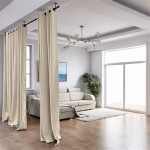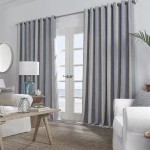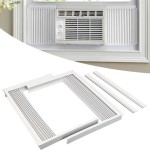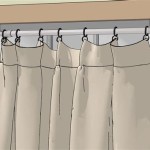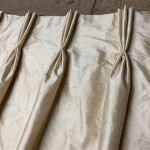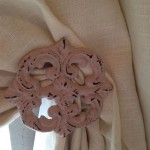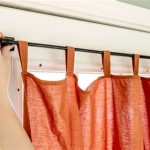Hooks To Hold Curtains Back: Functionality, Style, and Installation
Curtain holdbacks, also known as tiebacks, are functional and decorative hardware components used to secure curtains away from windows. These accessories enhance the aesthetic appeal of a room while maximizing natural light penetration. Choosing the right hooks to hold curtains back involves considering factors such as material, style, ease of installation, and compatibility with existing décor. This article will provide an in-depth exploration of various aspects related to curtain holdbacks, including their types, selection criteria, and installation techniques.
Types of Curtain Holdbacks
Curtain holdbacks are available in a diverse range of styles to complement different interior design themes. These can be broadly categorized based on their design and functionality.
Hooks: These are typically made of metal, resin, or wood and are mounted to the wall using screws. Hooks come in a variety of shapes and sizes, ranging from simple, minimalist designs to ornate, decorative styles. Single hooks are suitable for lighter curtains, while double hooks can accommodate heavier or layered drapes.
Arms: Curtain arm holdbacks consist of a projecting arm that extends from the wall, providing a secure point to hold the curtain. These are often made of metal and can be adjustable in length to accommodate different curtain widths. Arm holdbacks are particularly suitable for heavier curtains and can add a touch of elegance to a room.
Ropes and Tassels: These offer a softer, more traditional look. Ropes and tassels are typically made of fabric or woven materials and are wrapped around the curtain to hold it in place. They can be secured to a hook on the wall or simply tied around the curtain itself. Ropes and tassels are often chosen for their decorative value and can be used to add texture and color to a room.
Magnetic Holdbacks: These consist of two magnetic pieces that attach to the curtain fabric, holding it back without the need for wall-mounted hardware. Magnetic holdbacks are easy to use and can be repositioned as desired. They are particularly suitable for lightweight curtains and are a good option for renters or those who prefer not to drill into walls.
Wrap-Around Holdbacks: These feature a flexible arm that wraps around the curtain to hold it in place. Wrap-around holdbacks are made of metal or plastic and can be adjusted to accommodate different curtain thicknesses. They offer a clean, modern look and are easy to install.
Key Considerations When Selecting Curtain Holdbacks
Selecting the most appropriate hooks to hold curtains back requires careful consideration of several factors to ensure both functionality and aesthetic compatibility.
Material: The material of the holdback should be chosen based on the weight of the curtains and the overall style of the room. Metal holdbacks, such as those made of wrought iron or brushed nickel, are durable and suitable for heavier curtains. Resin or wooden holdbacks can provide a more decorative look and are well-suited for lighter curtains. The finish of the metal holdback should also be considered. Common finishes include brushed nickel, bronze, chrome, and black, each offering a distinct visual appeal. Matching the finish to other hardware in the room, such as doorknobs or light fixtures, can create a cohesive design scheme.
Style: The style of the holdback should complement the overall design of the room. For a classic or traditional room, ornate metal or rope tiebacks may be appropriate. For a more modern or minimalist room, simple metal hooks or magnetic holdbacks may be a better choice. Consider the existing décor, including the color scheme, furniture style, and other accessories, when selecting holdbacks. The goal is to choose holdbacks that enhance the room's overall aesthetic and create a harmonious look.
Size and Weight Capacity: The size and weight capacity of the holdback should be appropriate for the size and weight of the curtains. Larger, heavier curtains will require more robust holdbacks to ensure they are securely held in place. Consider the width and length of the curtains when selecting holdbacks. The holdbacks should be large enough to accommodate the gathered fabric without appearing strained or overwhelmed. It is important to check the manufacturer's specifications for weight capacity before purchasing holdbacks to ensure they can safely support the curtains.
Installation Requirements: The installation requirements of the holdback should be considered, especially for renters or those who prefer not to drill into walls. Wall-mounted holdbacks typically require drilling holes and inserting screws, while magnetic holdbacks require no installation. Screw-in holdbacks are generally more secure and can support heavier curtains, but they require more effort to install. Adhesive holdbacks offer a non-permanent solution, but their strength may be limited.
Placement and Positioning: The placement of the holdbacks on the wall is crucial for both functionality and aesthetics. Holdbacks are typically installed at a height that allows the curtains to drape gracefully when held back. A common guideline is to install the holdbacks about one-third of the way down from the top of the curtain. Experiment with different positions to find the most visually appealing and functional placement before permanently installing the holdbacks. Consider the amount of light and privacy desired when determining the placement of the holdbacks. Higher placement will allow more light to enter the room, while lower placement will provide more privacy.
Installing Curtain Holdbacks
Proper installation of curtain holdbacks is essential to ensure their functionality and longevity. The installation process may vary depending on the type of holdback, but the following general steps can be applied.
Gather Necessary Tools and Materials: Before beginning the installation, gather the necessary tools and materials. These may include a drill, screwdriver, pencil, measuring tape, level, and appropriate screws or anchors. Ensure the drill bits are the correct size for the screws being used. It is also helpful to have a stud finder to locate wall studs for added support, especially when installing holdbacks for heavier curtains. Having all the tools and materials readily available will streamline the installation process and prevent delays.
Mark the Desired Location: Use a pencil and measuring tape to mark the desired location for the holdbacks on the wall. Ensure the marks are level and symmetrical on both sides of the window. Use a level to ensure the marks are perfectly horizontal. Double-check the measurements to ensure the holdbacks will be positioned correctly and will hold the curtains in the desired position. Accurate marking is crucial for achieving a professional-looking installation.
Drill Pilot Holes: Use a drill to create pilot holes at the marked locations. The size of the pilot holes should be slightly smaller than the screws being used. Pilot holes help prevent the screws from stripping or damaging the wall. If installing holdbacks into drywall, use appropriate drywall anchors to provide added support. Ensure the anchors are properly inserted and are capable of supporting the weight of the curtains.
Attach the Holdbacks: Align the holdbacks with the pilot holes and use a screwdriver to attach them to the wall. Be careful not to overtighten the screws, as this can damage the holdbacks or the wall. Ensure the holdbacks are securely attached and do not wobble or feel loose. If using adhesive holdbacks, follow the manufacturer's instructions for proper application. Clean the wall surface thoroughly before applying the adhesive to ensure a strong bond. Apply firm pressure to the holdbacks for the recommended amount of time to allow the adhesive to set.
Test the Holdbacks: Once the holdbacks are installed, test them by holding the curtains back. Ensure the holdbacks are securely holding the curtains and that the curtains drape gracefully. Adjust the position of the curtains as needed to achieve the desired look. If the holdbacks appear to be straining or not holding the curtains securely, consider using larger or more robust holdbacks.
In addition to the above steps, it's crucial to consider specific installation instructions provided by the holdback manufacturer. Different holdback designs may require slightly different installation techniques. Consulting the manufacturer's guide can prevent potential errors and ensure a secure and visually appealing installation.
Choosing the right hooks to hold curtains back involves a careful evaluation of several factors, including material, style, size, weight capacity, and installation requirements. By considering these aspects, individuals can select holdbacks that not only enhance the aesthetic appeal of their rooms but also provide practical functionality. The installation process, while straightforward, demands precision and attention to detail to ensure secure and long-lasting performance of the holdbacks. With the right selection and installation, curtain holdbacks can significantly improve the look and feel of any room.

Curtain Tiebacks 101

Wrought Iron Curtain Tie Back With Scroll Design Metal Hold Backs Handmade Hooks Window Accessories Etsy Uk

Curtain Holder Shower Hooks Drapes Curtains Strap On Hold Hook Retainer Door For Hanging Adhesive Wall White Side Indoor Lazada Singapore

Where To Fit Curtain Tie Back Hooks For The Best Look

Holdbacks Jim Lawrence Curtain Tie Backs Handcrafted Quality Materials

Curtain Tiebacks 101

How To Tie Curtains 10 Steps With Pictures Wikihow

Metal Curtain Hold Backs Wall Mounted Tie Works Back Hooks Qhk063 Etsy

Black Next Set Of 2 Stud Curtain Holdbacks From The Uk

Curtain Tiebacks 101
See Also

